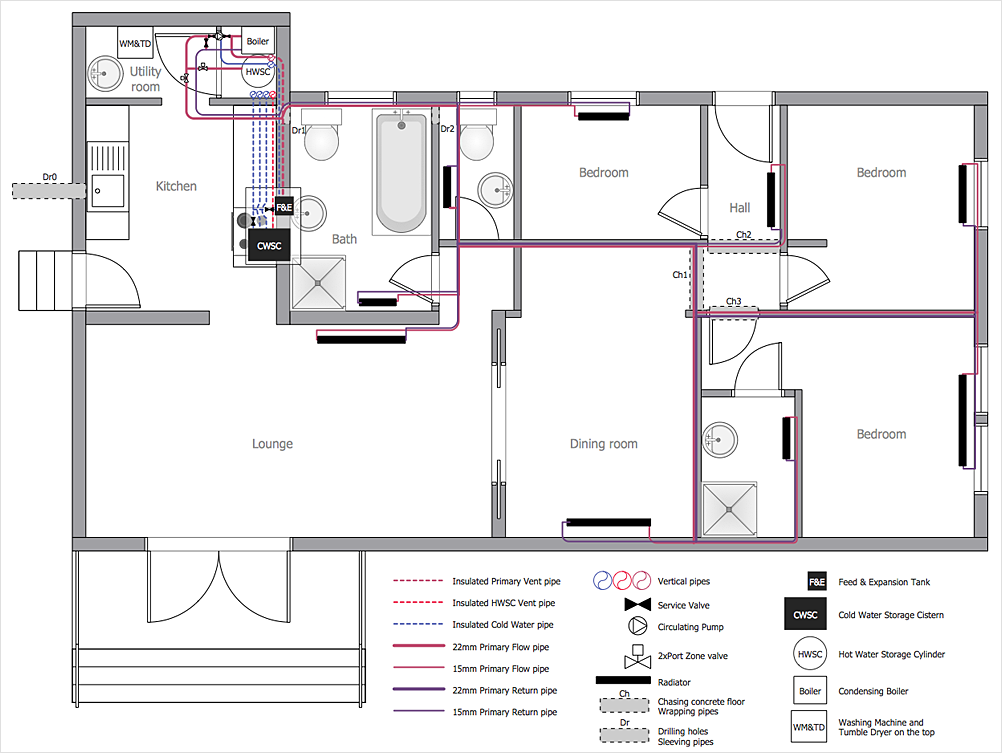Electrical, Plumbing & HVAC Layouts: A Guide for Interior Designers
Interior design isn’t just about aesthetics—it’s also about functionality and technical efficiency. A well-planned electrical, plumbing, and HVAC (Heating, Ventilation, and Air Conditioning) layout ensures that spaces are comfortable, energy-efficient, and compliant with safety standards.
Here’s what every interior designer needs to know about these essential systems.

1. Electrical Layout: Powering the Space
An electrical plan maps out the location of outlets, switches, lighting fixtures, and appliances, ensuring safety and functionality.
Key Components of an Electrical Layout:
✔️ Lighting Circuits – Placement of ambient, task, and accent lighting with appropriate wattage.
✔️ Power Outlets – Locations of switchboards, USB charging points, and high-load sockets (e.g., kitchen appliances).
✔️ Smart Home Features – Integration of motion sensors, dimmers, and automation systems.
Best Practices for Electrical Planning:
✔️ Plan for Future Needs – Include extra outlets to accommodate future technology.
✔️ Follow Standard Heights – Power sockets should be 12-18 inches from the floor, while light switches are typically at 48 inches.
✔️ Separate High & Low Power Circuits – Prevent overloads by designating circuits for lighting, HVAC, and heavy appliances.
📌 Pro Tip: Use different circuits for essential areas like kitchens and bathrooms to ensure safety during power surges.

2. Plumbing Layout: Water Supply & Drainage
A plumbing plan details the placement of water supply lines, drainage pipes, and sanitary fixtures to ensure an efficient system.
Key Components of a Plumbing Layout:
✔️ Water Inlets & Outlets – Identifies supply points for sinks, showers, washing machines, and water heaters.
✔️ Drainage & Venting – Ensures proper waste disposal and prevents water stagnation.
✔️ Fixture Placement – Defines ergonomic positioning of faucets, toilets, and bathtubs for easy access.
Best Practices for Plumbing Planning:
✔️ Keep Wet Areas Aligned – Bathrooms and kitchens should have short, direct plumbing lines to reduce installation costs.
✔️ Ensure Proper Venting – Vent pipes prevent clogs and foul odors in drainage systems.
✔️ Use Water-Efficient Fixtures – Opt for low-flow faucets and dual-flush toilets for sustainability.
📌 Pro Tip: Plan for separate gray water and black water drainage to enable water recycling.

3. HVAC Layout: Comfort & Air Quality
An HVAC system regulates temperature, humidity, and air circulation to create a healthy indoor environment.
Key Components of an HVAC Layout:
✔️ Air Conditioning & Heating Units – Placement of ducts, vents, and radiators for balanced airflow.
✔️ Ventilation Systems – Fresh air inlets and exhaust points to maintain air quality.
✔️ Thermal Insulation – Proper wall and ceiling insulation to improve energy efficiency.
Best Practices for HVAC Planning:
✔️ Avoid Blocking Airflow – Keep furniture away from vents and ducts for efficient cooling/heating.
✔️ Use Zoning Systems – Different temperature controls for living rooms, bedrooms, and offices.
✔️ Integrate Smart Thermostats – Automate temperature regulation for energy savings.
📌 Pro Tip: Position HVAC vents in strategic locations to maintain an even temperature distribution.
A well-designed electrical, plumbing, and HVAC layout is crucial for creating functional, safe, and comfortablespaces. Interior designers must collaborate with engineers and contractors to ensure proper execution.
What challenges have you faced when planning MEP (Mechanical, Electrical, Plumbing) layouts? Share your experiences below! 👇✨
Would you like more in-depth guides on any of these topics? Let me know! 🚀
